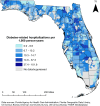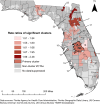Investigation of geographic disparities of diabetes-related hospitalizations in Florida using flexible spatial scan statistics: An ecological study
- PMID: 38833434
- PMCID: PMC11149881
- DOI: 10.1371/journal.pone.0298182
Investigation of geographic disparities of diabetes-related hospitalizations in Florida using flexible spatial scan statistics: An ecological study
Abstract
Background: Hospitalizations due to diabetes complications are potentially preventable with effective management of the condition in the outpatient setting. Diabetes-related hospitalization (DRH) rates can provide valuable information about access, utilization, and efficacy of healthcare services. However, little is known about the local geographic distribution of DRH rates in Florida. Therefore, the objectives of this study were to investigate the geographic distribution of DRH rates at the ZIP code tabulation area (ZCTA) level in Florida, identify significant local clusters of high hospitalization rates, and describe characteristics of ZCTAs within the observed spatial clusters.
Methods: Hospital discharge data from 2016 to 2019 were obtained from the Florida Agency for Health Care Administration through a Data Use Agreement with the Florida Department of Health. Raw and spatial empirical Bayes smoothed DRH rates were computed at the ZCTA level. High-rate DRH clusters were identified using Tango's flexible spatial scan statistic. Choropleth maps were used to display smoothed DRH rates and significant high-rate spatial clusters. Demographic, socioeconomic, and healthcare-related characteristics of cluster and non-cluster ZCTAs were compared using the Wilcoxon rank sum test for continuous variables and Chi-square test for categorical variables.
Results: There was a total of 554,133 diabetes-related hospitalizations during the study period. The statewide DRH rate was 8.5 per 1,000 person-years, but smoothed rates at the ZCTA level ranged from 0 to 101.9. A total of 24 significant high-rate spatial clusters were identified. High-rate clusters had a higher percentage of rural ZCTAs (60.9%) than non-cluster ZCTAs (41.8%). The median percent of non-Hispanic Black residents was significantly (p < 0.0001) higher in cluster ZCTAs than in non-cluster ZCTAs. Populations of cluster ZCTAs also had significantly (p < 0.0001) lower median income and educational attainment, and higher levels of unemployment and poverty compared to the rest of the state. In addition, median percent of the population with health insurance coverage and number of primary care physicians per capita were significantly (p < 0.0001) lower in cluster ZCTAs than in non-cluster ZCTAs.
Conclusions: This study identified geographic disparities of DRH rates at the ZCTA level in Florida. The identification of high-rate DRH clusters provides useful information to guide resource allocation such that communities with the highest burdens are prioritized to reduce the observed disparities. Future research will investigate determinants of hospitalization rates to inform public health planning, resource allocation and interventions.
Copyright: © 2024 Lord, Odoi. This is an open access article distributed under the terms of the Creative Commons Attribution License, which permits unrestricted use, distribution, and reproduction in any medium, provided the original author and source are credited.
Conflict of interest statement
The authors have declared that no competing interests exist.
Figures





Similar articles
-
Determinants of disparities of diabetes-related hospitalization rates in Florida: a retrospective ecological study using a multiscale geographically weighted regression approach.Int J Health Geogr. 2024 Jan 6;23(1):1. doi: 10.1186/s12942-023-00360-5. Int J Health Geogr. 2024. PMID: 38184599 Free PMC article.
-
Investigation of geographic disparities and temporal changes of non-gestational diabetes-related emergency department visits in Florida: a retrospective ecological study.PeerJ. 2025 Jan 31;13:e18897. doi: 10.7717/peerj.18897. eCollection 2025. PeerJ. 2025. PMID: 39902319 Free PMC article.
-
Geographic disparities and temporal changes of diabetes-related mortality risks in Florida: a retrospective study.PeerJ. 2024 Jun 27;12:e17408. doi: 10.7717/peerj.17408. eCollection 2024. PeerJ. 2024. PMID: 38948203 Free PMC article.
-
Geographic disparities and temporal changes of diabetes prevalence and diabetes self-management education program participation in Florida.PLoS One. 2021 Jul 16;16(7):e0254579. doi: 10.1371/journal.pone.0254579. eCollection 2021. PLoS One. 2021. PMID: 34270601 Free PMC article.
-
Risk factors for persistent fatal opioid-involved overdose clusters in Massachusetts 2011-2021: a spatial statistical analysis with socio-economic, accessibility, and prescription factors.BMC Public Health. 2024 Jul 15;24(1):1893. doi: 10.1186/s12889-024-19399-5. BMC Public Health. 2024. PMID: 39010038 Free PMC article.
Cited by
-
Determinants of disparities of diabetes-related hospitalization rates in Florida: a retrospective ecological study using a multiscale geographically weighted regression approach.Int J Health Geogr. 2024 Jan 6;23(1):1. doi: 10.1186/s12942-023-00360-5. Int J Health Geogr. 2024. PMID: 38184599 Free PMC article.
References
-
- Centers for Disease Control and Prevention. National Diabetes Statistics Report website. 2022.
-
- American Diabetes Association Professional Practice Committee. Classification and Diagnosis of Diabetes: Standards of Medical Care in Diabetes—2022. Diabetes Care. 2022. Jan;45(Supplement_1):S17–38. - PubMed
MeSH terms
LinkOut - more resources
Full Text Sources
Medical

